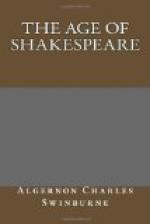in the play which Marston published next year—“Parasitaster;
or, the Fawn”; a name probably suggested by that
of Ben Jonson’s “Poetaster,” in
which the author had himself been the subject of a
greater man’s rage and ridicule. The wealth
and the waste of power displayed and paraded in this
comedy are equally admirable and lamentable; for the
brilliant effect of its various episodes and interludes
is not more obvious than the eclipse of the central
interest, the collapse of the serious design, which
results from the agglomeration of secondary figures
and the alternations of perpetual by-play. Three
or four better plays might have been made out of the
materials here hurled and huddled together into one.
The Isabelle of Moliere is not more amusing or more
delightful in her audacity of resource, in her combination
of loyalty with duplicity, innocence with intrigue,
than the daring and single-hearted young heroine of
this play; but the “Ecole des Maris” is
not encumbered with such a crowd of minor interests
and characters, of subordinate humors and complications,
as the reader of Marston’s comedy finds interposed
and intruded between his attention and the main point
of interest. He would fain see more of Dulcimel
and Tiberio, the ingenious and enterprising princess,
the ingenuous and responsive prince; he is willing
to see as much as is shown him of their fathers, the
masquerading philosopher and the self-complacent dupe;
Granuffo, the patrician prototype of Captain John Bunsby,
may take a seat in the chambers of his memory beside
the commander of the Cautious Clara; the humors of
a jealous foul-minded fool and a somewhat audaciously
virtuous wife may divert him by the inventive and vigorous
exposure of their various revolutions and results;
but the final impression is one of admiring disappointment
and possibly ungrateful regret that so much energetic
satire and so much valuable time should have been
spent on the somewhat nauseous follies of “sickly
knights” and “vicious braggarts”
that the really admirable and attractive parts of
the design are cramped and crowded out of room for
the due development of their just and requisite proportions.
A more eccentric, uneven, and incomposite piece of
work than “The Insatiate Countess” it
would be difficult to find in English or in other
literature. The opening scene is picturesque and
impressive; the closing scene of the serious part
is noble and pathetic; but the intervening action
is of a kind which too often aims at the tragic and
hits the burlesque. The incessant inconstancy
of passion which hurries the fantastic heroine through
such a miscellaneous multitude of improvised intrigues
is rather a comic than a tragic motive for the conduct
of a play; and the farcical rapidity with which the
puppets revolve makes it impossible for the most susceptible
credulity to take any real interest or feel any real
belief in the perpetual rotation of their feverish
moods and motives, their irrational doings and sufferings.




